On this page you’ll learn about the dinosaur periods of the Mesozoic Era – the ‘Age of Reptiles’.
We’ll look at each of the three ‘dinosaur periods’ – the Triassic, Jurassic and Cretaceous – and find out what life on Earth was like in those times.
- You can find out more about dinosaurs at our main Dinosaur Facts page.
- Find out more about the Triassic Period here: Triassic Period Facts
- Find out more about the Jurassic Period here: Jurassic Period Facts
- Find out more about the Cretaceous Period here: Cretaceous Period Facts
Dinosaur Periods of the Mesozoic Era
Dinosaurs were alive in the Triassic, Jurassic and Cretaceous periods. Together, these three periods make up the Mesozoic Era. Due to the dominance of the dinosaurs and other reptiles during the Mesozoic Era, it has become known as the ‘Age of Reptiles’.
Mesozoic Era (252.17 to 66 million years ago)
- Triassic Period (252.17 to 201.3 million years ago): Dinosaurs begin to appear, having evolved from reptiles called Archosaurs.
- Jurassic Period (201.3 – 145 million years ago): Dinosaurs become the dominant land vertebrates.
- Cretaceous Period (145 – 66 million years ago): Dinosaurs continue to thrive and diversify.
- Cretaceous–Paleogene Extinction Event (around 66 million years ago): The dinosaurs are wiped out; only avian dinosaurs (birds) survive.
Further down the page you’ll find information on each of the three periods of the Mesozoic Era, including examples of the dinosaurs that existed during each period.
Mesozoic Era: ‘Age of Reptiles’
The Mesozoic Era lasted for around 186 million years. It began around 252.17 million years ago, and ended around 66 million years ago. Dinosaurs started to appear around 243 to 231 million years ago, during the Triassic Period.
Dinosaurs are among the most successful groups of animals ever to have lived. They walked the Earth for around 170 million years. (Bear in mind that humans have only existed for 2 million years, and that Homo sapiens (modern humans) only appeared around 315,000 years ago!)
Dinosaur Periods: Extinction
Despite their success, the dinosaurs’ reign finally came to an abrupt end.
The Mesozoic Era ended with the ‘Cretaceous–Paleogene Extinction Event’, which wiped out the dinosaurs and many other species.
(An extinction event is a sudden and wide-ranging decrease in the amount of life on Earth.)
Divisions Of The Mesozoic Era
As we’ve seen, the Mesozoic Era is subdivided into three periods: the Triassic, Jurassic and Cretaceous periods. These are 'geological periods' of time: each corresponds to a particular layer of rock.
The scientific body responsible for measuring the geological timescale is the International Commission on Stratigraphy.
In the geological timescale, each period is further divided into ‘epochs’. The Triassic and Jurassic periods are divided into three epochs, the Cretaceous into two.
Mesozoic Era (252.17 to 66 million years ago)
- Triassic Period (252.17 to 201.3 million years ago)
- Early Triassic Epoch (252.17 - 247.2 million years ago)
- Middle Triassic Epoch (247.2 - 237 million years ago)
- Late Triassic Epoch (237 - 201.3 million years ago)
- Jurassic Period (201.3 – 145 million years ago)
- Early Jurassic Epoch (201.3 to 174.1 million years ago)
- Middle Jurassic Epoch (174.1 to 163.5 million years ago)
- Late Jurassic Epoch (163.5 to 145 million years ago)
- Cretaceous Period (145 – 66 million years ago)
- Early Cretaceous Epoch (145 to 100.5 million years ago)
- Late Cretaceous Epoch (100.5 to 66 million years ago)
The Age of the Dinosaurs
Let’s find out what the world was like during the three ‘dinosaur periods’ of the Mesozoic Era …
1: Triassic Period (252.17 to 201.3 million years ago)
The Eoraptor is one of the first dinosaurs. It appeared during the Triassic Period.
The Triassic Period followed the worst extinction event that the world has ever experienced. (Yes, it was even worse than the later extinction event that would wipe out the dinsoaurs.)
The Permian-Triassic Extinction Event, or the ‘Great Dying’ as it is otherwise known, caused between 90% and 96% of all species on Earth to became extinct.
At the beginning of the Triassic Period, life on Earth struggled to rebuild itself. At first, the mammal-like reptiles, successful before the extinction event, started to dominate once again.
Mammal-like animals such as the Lystrosaurus – a strange, dog-sized animal with tusks – thrived in the Early Triassic. Mammals themselves would appear towards the end of the Triassic Period.
However, it was another group of animals that would win the race to supremacy: the Archosaurs. Through the course of the Triassic Period, these reptiles became the dominant land vertebrates (animals with backbones).
As the Triassic Period progressed, the archosaurs split into two main branches. One of these was the Pseudosuchia, which includes the Crocodilians, and similar animals. The other branch was the Avemetatarsalia, which itself split into Pterosaurs and Dinosaurs.
The first dinosaurs were, small, walked on two legs, and ate meat.
In the Triassic period, all of the world’s land was joined together in one vast supercontinent called ‘Pangaea’, which means ‘whole Earth’. The climate was hot and dry. The interior of Pangaea was a vast desert.
Plants such as conifers and ginkgoes flourished. There was no grass, and there were no flowering plants.
When Were Dinosaurs Alive: Triassic Period Dinosaurs
One of the earliest dinosaurs was the Eoraptor, a small predator that lived around 228 million years ago (see picture, above). Found in north-west Argentina, it walked on two legs and stood knee-high to a human.
Eoraptor looked like a 'typical' dinosaur, with a long tail, long neck and short arms.
Saurischia and Ornithischia
Eoraptor was a saurischian, one of the two main types of dinosaur. All of the meat-eating dinosuars were saurichians, as were many of the large, four-legged plant eaters.
The other main type of dinosaur was ornithischia. The Ornithischians were all herbivores (plant-eaters)
One of the earliest known Ornithischians is the Pisanosaurus. This was a small dinosaur that walked on two legs, and outwardly looked much like early bipedal (2-legged) saurichians.
When Were Dinosaurs Alive: Triassic Period Dinosaurs
- Eoraptor
- Pisanosaurus
- Coelophysis
- Melanorosaurus
- Plateosaurus
2: Jurassic Period (201.3 – 145 million years ago)
The Jurassic Period began with another extinction event – the Triassic-Jurassic Extinction Event. While not quite as devastating as the earlier Permian-Triassic Extinction Event, it still led to a substantial decline in both sea and land species.
The extinction set the scene for dinosaurs – who were already flourishing by the end of the Triassic – to completely dominate the land.
Pangaea began to break apart in the Jurassic Period, forming two landmasses, Laurasia in the north, and Gondwana in the south. As the continents separated, the climate became wetter and more humid.
Conifer forests covered much of the land, especially near the poles. Ginkgoes, palms, tree-ferns and horse-tails were also present. The first birds appeared. Insects and amphibians continued to develop. Mammals evolved fur coats and started giving birth to live young.
Huge sauropods such as Brachiosaurus walked the land, feeding on the flourishing vegetation. Large predators, such as Allosaurus also made an appearance.
When Were Dinosaurs Alive: Jurassic Period Dinosaurs
Examples of Early Jurassic Dinosaurs
- Scutellosaurus
- Scelidosaurus
- Massospondylus
Examples of Mid Jurassic Dinosaurs
- Megalosaurus
- Huayangosaurus
Examples of Late Jurassic Dinosaurs
- Allosaurus
- Apatosaurus
- Archaeopteryx
- Eumaniraptoria
- Brachiosaurus
- Compsognathus
- Diplodocus
- Stegosaurus
3. Cretaceous Period (145 – 66 million years ago)
During the Cretaceous Period, the continents continued to separate. Gondwana broke up to form South America and Africa, and Antarctica and Australia also drifted away. Laurasia began to split into North America, Europe and Asia. The world – as we know it today – began to take shape.
The climate became wetter, and the newly formed oceans offered new habitats.
Flowering plants appeared in Laurasia at the beginning of the Cretaceous Period. By the end of the Cretaceous they were the Earth's dominant plant type. Oak, maple and beech trees were all present. Insects evolved alongside the new plants.
When Were Dinosaurs Alive: Cretaceous Period Dinosaurs
Although some types of dinosaur, such as the Stegosaurs, died out during the Cretaceous Period, ever-more varied types evolved to take their places.
Duck-billed dinosaurs such as Iguanodon, armoured dinosaurs such as Polacanthus, and the Ceratopsids, including Triceratops, all thrived during the Cretaceous Period.
With the decline of the Allosaurus, came the rise of fearsome predators such as such as Tyrannosaur and Velociraptor.
Cretaceous–Paleogene Extinction Event
Many of these dinosaurs existed right up to the end of the Cretaceous Period. However, 66 million years ago, the Earth was rocked by a catastrophic event that wiped out over 75% of all living species.
This was the Cretaceous–Paleogene Extinction Event, and it brought the whole Mesozoic Era to a close. At the dawn of the Cenozoic Era, the only dinosaurs still alive were the birds.
All of the non-avian dinosaurs had become extinct.
Scientists believe that the Cretaceous–Paleogene Extinction Event (which is also known as the K–Pg extinction event, or Cretaceous–Tertiary (K–T) extinction event) was caused by a large asteroid striking the Earth.
The explosion would have thrown up a dust cloud big enough to hide the sun for months, or even years. Plants would have been unable to grow in the darkness, and many of the Earth’s animals – including the dinosaurs – would have been unable to find enough food to survive.
The age of the dinosaurs had come to an end.
Examples of Early Cretaceous Dinosaurs
- Archaeoceratops
- Baryonyx
- Iguanodon
- Microraptor
- Minmi
- Utahraptor
Examples of Late Cretaceous Dinosaurs
- Albertosaurus
- Edmontosaurus
- Oviraptor
- Parasaurolophus
- Protoceratops
- Spinosaurus
- Stegoceras
- Triceratops
- Troodon
- Tyrannosaurus
- Velociraptor
Dinosaur Periods: When Were Dinosaurs Alive - Conclusion
The Mesozoic Era is subdivided into three periods: the Triassic, Jurassic and Cretaceous periods.
Dinosaurs first appeared towards the end of the Triassic Period. Following the Triassic-Jurassic extinction event, the dinosaurs quickly became the dominant land animals on Earth. They would remain so throughout the Jurassic and Cretaceous Periods.
The dinosaurs became increasingly diverse throughout the Cretaceous Period, and thrived right up to the Cretaceous–Paleogene Extinction Event.
This extinction event, believed to have been caused by a large asteroid striking the Earth, wiped out all of the (non-avian) dinosaurs. Only avian dinosaurs – or birds – survived. (Many scientists today believe that birds are actually dinosaurs, meaning that birds are the only dinosaurs to have survived the extinction event).
We hope that you’ve enjoyed reading about the three ‘dinosaur periods’ of the Mesozoic Era.
Discover More at Active Wild
You can find more dinosaur information on our main Dinosaur Facts page, or check out these pages for in-depth dino facts:
- Find out more about the Triassic Period here: Triassic Period Facts
- Find out more about the Jurassic Period here: Jurassic Period Facts
- Find out more about the Cretaceous Period here: Cretaceous Period Facts
- Tyrannosaurus Rex Facts
- Allosaurus Facts

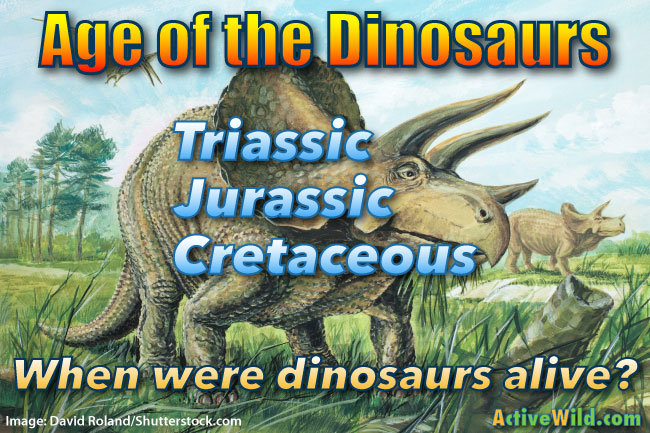
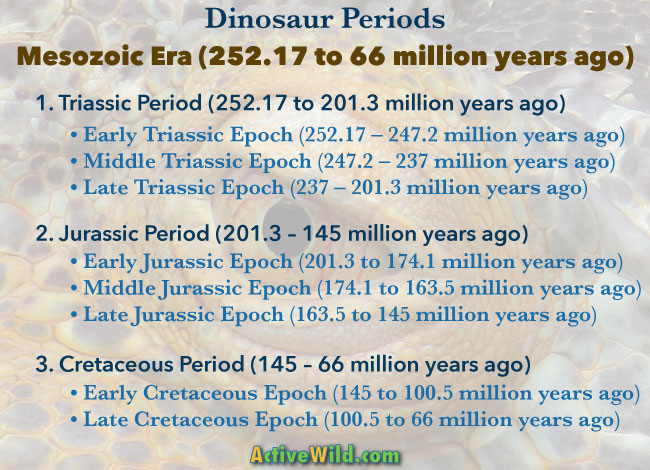
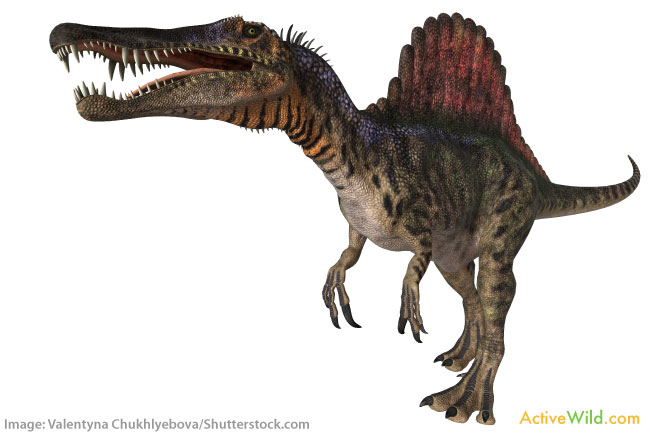

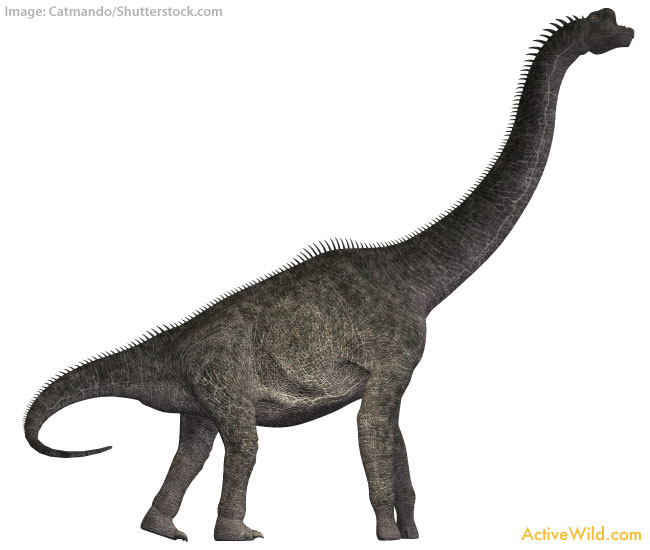
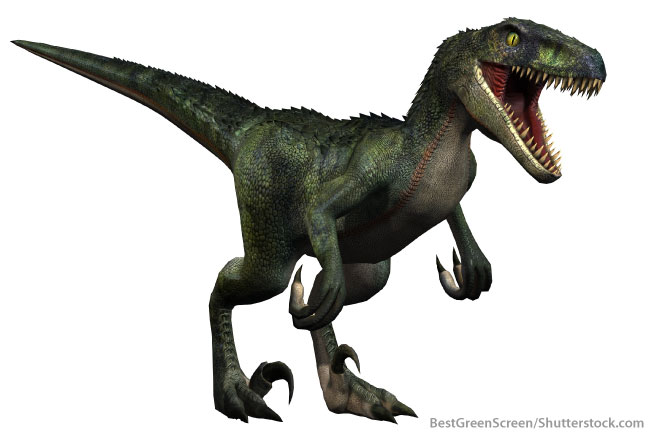
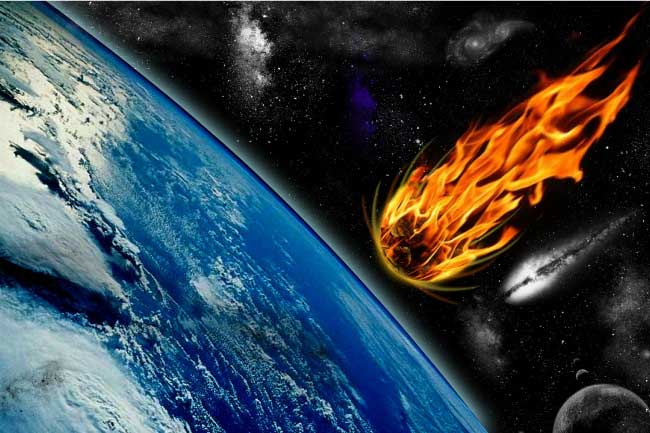

Thanks for the article. Helpful in designing a Dino-chart for my son 🙂
You’re welcome! Thank you for your message! 🦖👍
Why do the ages for dinosaurs not match the age of the earth? The age of the earth is approximated by using the Bible. I know that they existed, but the ages are following theories, not facts. The bible gives specific information for the creation of life and for it’s existence. I’ve started collecting information as I come across it, stating how long ago something was thought have existed. I’ve never seen such nonsense and most do not agree with each other. Theories are only guesses and misinformation is built on it. Even all the theories don’t match. Darwin seems to be the most influential in thinking we evolved over time. If that’s true, why are there ‘monkey’s changing into people today? The Lord God Almighty created everything, what you call evolving is really adapting to the environment that is lived in. It’s time to be honest and realistic in putting information for the public. Maybe you need to sit down and read the Bible beginning in Genesis!